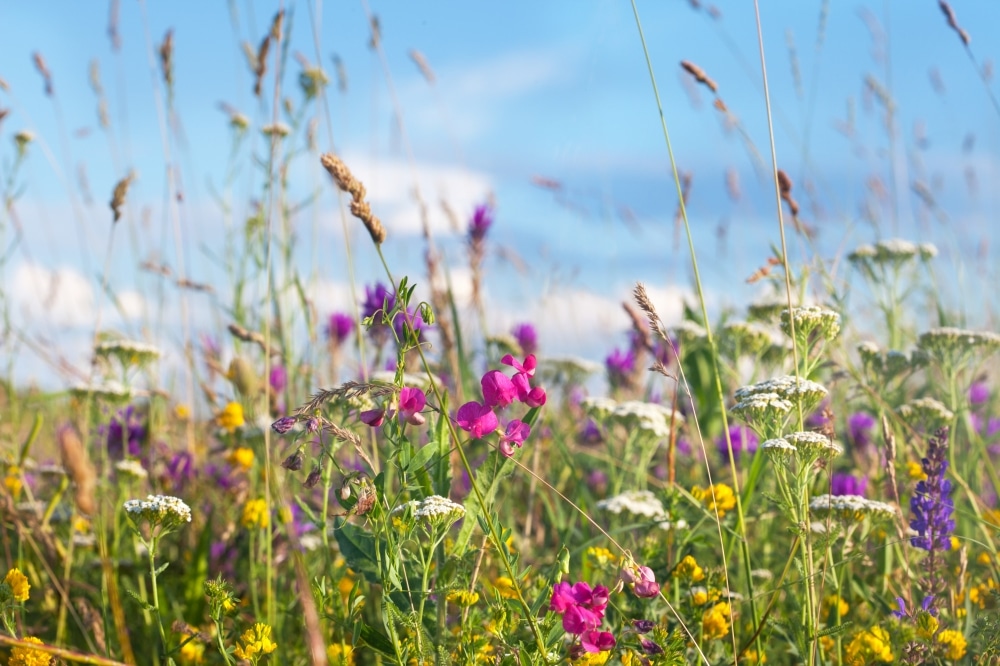If you are bored of looking at a flat, green piece of lawn and would like something that will flower most of the summer whilst also providing a haven for insects and pollinators look no further than sowing or installing a wildflower seed mix or wildflower turf.
There are varying mixes of wildflower seeds which come back year after year. Normally the first year after sowing they don’t produce many flowers but by the second year of growth and thereafter they will be prolific.
If you chose a mix that has successional flowering you will be rewarded every month with a high impact floral display providing drama and colour from early spring to late autumn. A meadow mix only requires one annual cut and clear once established.
Wildflower turf is a simpler and easier way to have an instant lawn. It consists of 100 per cent meadow plantlets growing in a special substrate which ensure complete consistency.
No grass is used in the mixes as this can quickly out-compete the perennial floral species. The turf is sent freshly harvested from the field in flat sections. The wildflower turf will arrive on a pallet and can be easily lifted off it and laid by two people.
Some of the seed mixes on Pictorial Meadows’ website have names that evoke the colours of the flowers once they are established.
An example is Golden Summer which is an exuberant, warm and visually stunning colour-themed meadow for normal fertility soils. This mix establishes a really ecologically stable carpet of flowers showing continuous waves of colour and form from late spring right through to late autumn.
As the name suggests, yellows and golds predominate but they are softened by whites and cream with hints of orange and purple later to give a lovely subtle contrast. This meadow turf is not fussy about soil types but grows particularly well in free-draining, sunny locations.
Horticultural hotspot: Pictorial Meadows
Pictorial Meadows was born 20 years ago out of an intensive research programme undertaken by Professor Nigel Dunnett of the University of Sheffield, the world’s leading centre for naturalistic planting.
The initial project was to develop beautiful meadows that would thrive on average garden soils. These would not need the ‘starvation’ regime normally associated with traditional wildflower meadows. A radically different approach to meadow landscapes emerged which combined ecology with design.
Experimental plots established in Sheffield provided a way to continually improve designs. The beds also enabled research into the care and establishment of meadows, which has made them accessible to everyone.
To find out more visit www.pictorialmeadows.co.uk
June’s jobs for the garden
1 Start planning your spring and summer garden by ordering a selection of beautiful bedding plants, including begonias, busy Lizzies and petunias which will give you instant colour
2 Sow seeds of annual flowers to fill gaps. Mix the seeds into sand or cover seeds with a mix of potting compost and sand so you can easily spot which areas you have sown and don’t enthusiastically hoe or pull up seedlings by mistake. Remember to keep the soil moist until they have germinated and the seedlings have grown into their space.
3 Keep pulling weeds. Little and often works best – five minutes here and there, aiming to pull them before they flower and set seed.
4 Divide bearded irises a couple of weeks after they have finished flowering. Lift plants, break off the older parts of the rhizome and keep the firm plump pieces. Trim the leaves to just above the fan as this reduces stress, and replant facing the sun, with the top of the rhizome just visible as they need to soak up the sun.
5 Keep sowing salad leaves and lettuces. If you find them too fiddly try using seed tape – seeds set into paper tape. A very clever way of ensuring you don’t sow too thickly. Plus it ensures straight rows. They are a bit more expensive but satisfying.
6 Sow spinach and kale. Both are useful crops that are easy to grow and good to eat. Sow F1 varieties for reliable performance. Use thinnings for salads.
7 Keep mowing the grass weekly
8 Trim herbs to help the plants keep their shape and grow better. Dry trimmings using the fan only setting (i.e. no heat) in your oven. Or freeze them in small quantities – little plastic snack bags are perfect for this.
9 Keep deadheading flowers and give weekly feeds of liquid seaweed or similar.
10 Look out for slugs and snails hiding in nooks and crannies. They’ll be out in force coming after all those tender young shoots coming up this month. Hunts are best done in early morning and evening when cool damp air brings them into the open. Depending on how much of a problem they are in the garden you can try various control methods. Nematodes (microscopic organisms that predate on slugs and snails) are organic and safe with pets and children but require careful application.








